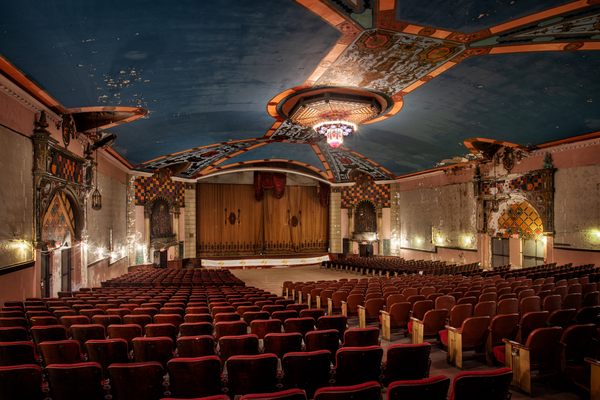Brooklyn’s Long-Abandoned Kings Theatre Resurrects to Its Movie Palace Glory
Kings Theatre on Flatbush (photograph by Allison Meier)
The ruins of America’s great movie palaces are now almost as famous as their original splendor. Driven out of business by franchises and waning interest in one grand space showing one film at a time, the velvet curtains in their gilded interiors fell one by one. On Flatbush Avenue in Brooklyn, the Kings Theatre has been abandoned for nearly four decades, its roof caving in and water streaming over the sculpted faces and towering columns meant to be a 20th-century version of the Opera Garnier in Paris.
Numerous failed restoration projects were pitched since it closed in 1977, but finally last year the Kings Theatre Redevelopment Company, with heavy backing from the city, broke ground on a $93 million restoration and modernization project. Now set to reopen in January of next year, the over 3,000-seat complex is nearing its second chance as the biggest theater in the borough.
This Tuesday, Atlas Obscura joined a hardhat tour of the Kings Theatre, where corners of the French Renaissance Revival still in their crumbled state contrasted to the meticulous reconstruction by Martinez+Johnson Architecture and Evergreene Architectural Arts with general contractor Gilbane. Chicago-based architecture firm Rapp & Rapp designed the Kings Theatre as one of Loew’s five extravagant “Wonder Theatres” in the New York City area (three of these are now churches, while the one in Jersey City still screens movies and hosts music). The 1027 Flatbush Avenue location was unique when it opened in 1929 as being at the end of the silent film age, merging sound and vaudeville entertainment from the beginning with its screenings.
In the lobby of the Kings Theatre (photograph by Dylan Thuras)
The Kings Theatre auditorium (photograph by Dylan Thuras)
Gary Martinez of Martinez+Johnson Architecture described the theatre as a “spatial progression of rooms,” and as we moved from the lobby with its conjoined soaring spaces, into the over 80-foot-tall auditorium, it did open up in an incredible way that its terracotta façade now peaking out from behind construction boards only hints at. Each room has its own aesthetic patterns and design techniques, the only visuals repeating are the numerous sculpted faces that gaze down at you from every angle, often hidden in floral flourishes or positioned high on the ceilings.
Bringing the structure out of deterioration required a “forensic investigation” as Martinez described it, into how the Kings Theatre was built, from taking paint samples for microscopic analysis to examining archive photographs. They even happened to get in touch with a former house manger who had kept some of the original furniture which will reappear in the lobby. Anywhere too waterlogged or vandalized is being carefully replicated as seamlessly as possible with molds to match the plaster walls, and the exact tree species to blend with the wood paneling. An additional structure is now hidden behind the stage to add loading docks and dressing rooms, while the sight lines of all the seats were reconsidered for stage shows rather than film.
Soon the restored crystal chandeliers will be rehung, the hundreds of plush seats installed, and then the next challenge will be to reestablish the Kings Theatre as an entertainment hub for performance, rather than its decades-long identity as one of the city’s most incredible ruins. Below are more photographs from the theatre, and to get an idea of what it looked like before, we recommend checking out Matt Lambros at After the Final Curtain’s beautiful series of photographs from 2011.
All photographs by Dylan Thuras and Allison Meier.
All photographs by Dylan Thuras and Allison Meier. Visit Kings Theatre for more on its reopening.








Follow us on Twitter to get the latest on the world's hidden wonders.
Like us on Facebook to get the latest on the world's hidden wonders.
Follow us on Twitter Like us on Facebook